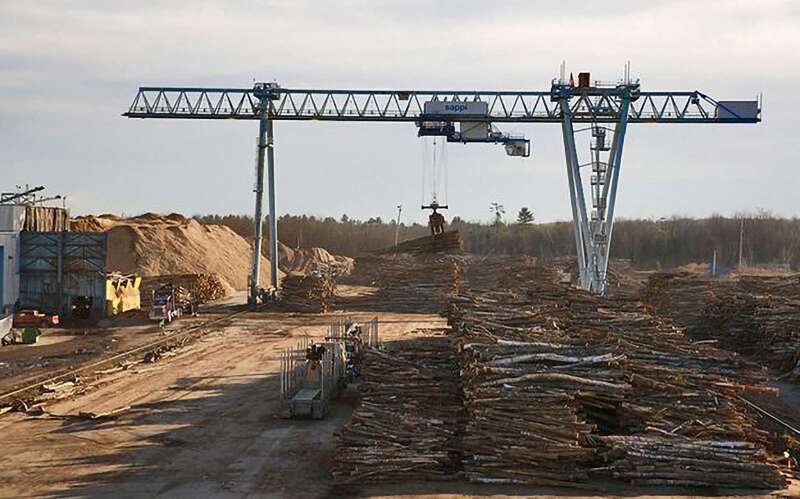
Report: Shortage of loggers and truckers hinders growth of $8.5B forest products industry
 Photo / James McCarthy
Dana Doran, executive director of the Professional Logging Contractors of Maine. The trade group representing Maine loggers released on Thursday a report concluding that Maine faces a shortage of loggers and log truckers that will get worse and could hinder the growth of the $8.5 billion forest products industry in the state if wage growth does not occur.
Photo / James McCarthy
Dana Doran, executive director of the Professional Logging Contractors of Maine. The trade group representing Maine loggers released on Thursday a report concluding that Maine faces a shortage of loggers and log truckers that will get worse and could hinder the growth of the $8.5 billion forest products industry in the state if wage growth does not occur.
A new report concludes that Maine faces a shortage of loggers and log truckers that will get worse — if wage growth does not occur — and could hinder the growth of the $8.5 billion forest products industry in the state.
The employment availability and wage analysis prepared by the Maine Center for Business and Economic Research at the University of Southern Maine found wages for logging equipment operators and log truckers are lower than those for comparable jobs in competing industries in the state.
Combined with a tight labor market and looming retirement for large numbers of loggers, that finding highlights a weak link in Maine’s forest economy, according to the trade group that commissioned the study.
“This analysis simply confirms and reinforces what many in the industry have known for a long time,” said Dana Doran, executive director of the Professional Logging Contractors of Maine, which commissioned and partnered with the center on the study. “The root of Maine’s vital forest products economy — the logging industry — must be able to offer higher wages to compete for existing workers and attract new ones at a time when they are desperately needed to support a resurgent forest products industry.”
Doran said the heart of the problem is profit margins for logging contractors have dwindled as costs of doing business have risen, limiting the ability of contractors to raise pay for workers. With low unemployment and strong competition for skilled operators of heavy machinery and trucks, logging contractors are struggling simply to keep the workers they have, let alone attract new ones, he said.
“We know from surveying our own membership, which cuts approximately 75% of all wood harvested in Maine, that the industry is already unable to fill an estimated 750 to 1,000 jobs today,” Doran said. “Add to that the projected loss of upwards of 200 workers per year over the next 10 years due to retirements, coupled with the need for more loggers and truckers to meet rising demand for wood from expansions that have been announced by mills in the state recently, and you begin to see the extent of this problem.”
Growth opportunities

Doran said that in addition to Maine expansions already announced by mill owners including Verso, Sappi, Nine Dragon, and Pleasant River Lumber, the FOR/Maine (Forest Opportunity Roadmap) has announced an action plan to grow Maine’s forest economy from the $8.5 billion annually to $12 billion by 2025.
That action plan was developed by a coalition working to diversify the state’s wood products businesses, attract capital investments and develop greater economic prosperity for communities affected by recent mill closures. The growth would position the state to compete in and take advantage of substantial global market opportunities with much of the projected 40% growth coming from new markets for the state.
Such growth would also require a significant expansion of the logging and log trucking workforce in Maine, Doran said.
Highlights of the report
Key findings of the employment availability and wage study include:
- Although capital expenses in the logging industry have risen across the board, rates for wood harvesting and trucking have not.
- Recently announced expansions increasing demand for wood will require an additional 100 jobs in the logging industry in the immediate future. In addition, occupation projections suggest upwards of 200 workers per year will need to be replaced over the next eight to 10 years due to an aging logger workforce.
- Business-critical occupations in the logging industry, including equipment operators and truck drivers, which comprise two out of every three jobs, earn relative wages well below comparable occupations in other industries, making it difficult to recruit and attract workers. Logging equipment operators ranked lowest for wages out of 19 comparable skilled occupations surveyed, while logging truck drivers ranked second to last for wages out of 14 heavy truck driving sectors.
- The average earnings for all employment in Maine’s logging industry have increased by 5% since 2010, an average increase of just over $2,100 per worker compared to an average increase of $5,500 in comparative industries, such as construction, wood manufacturing, and pulp and paper manufacturing.
- More than 400 workers in the industry are at retirement age (65-plus), while an additional 850 workers will reach retirement age within the next 10 years. Attracting younger workers is critical in replacing the retiring workforce.
- Based on 2018 data, an estimated 4,927 jobs were directly supported by traditional (paid employee), self-employed and proprietor income employment in logging. This supported another 3,266 jobs from indirect and induced spending impacts. In addition, a total of $320.8 million in compensation were supported by direct, indirect, and induced employment from the logging industry.
For the executive summary of the study go online here.
DOWNLOAD PDFs










0 Comments